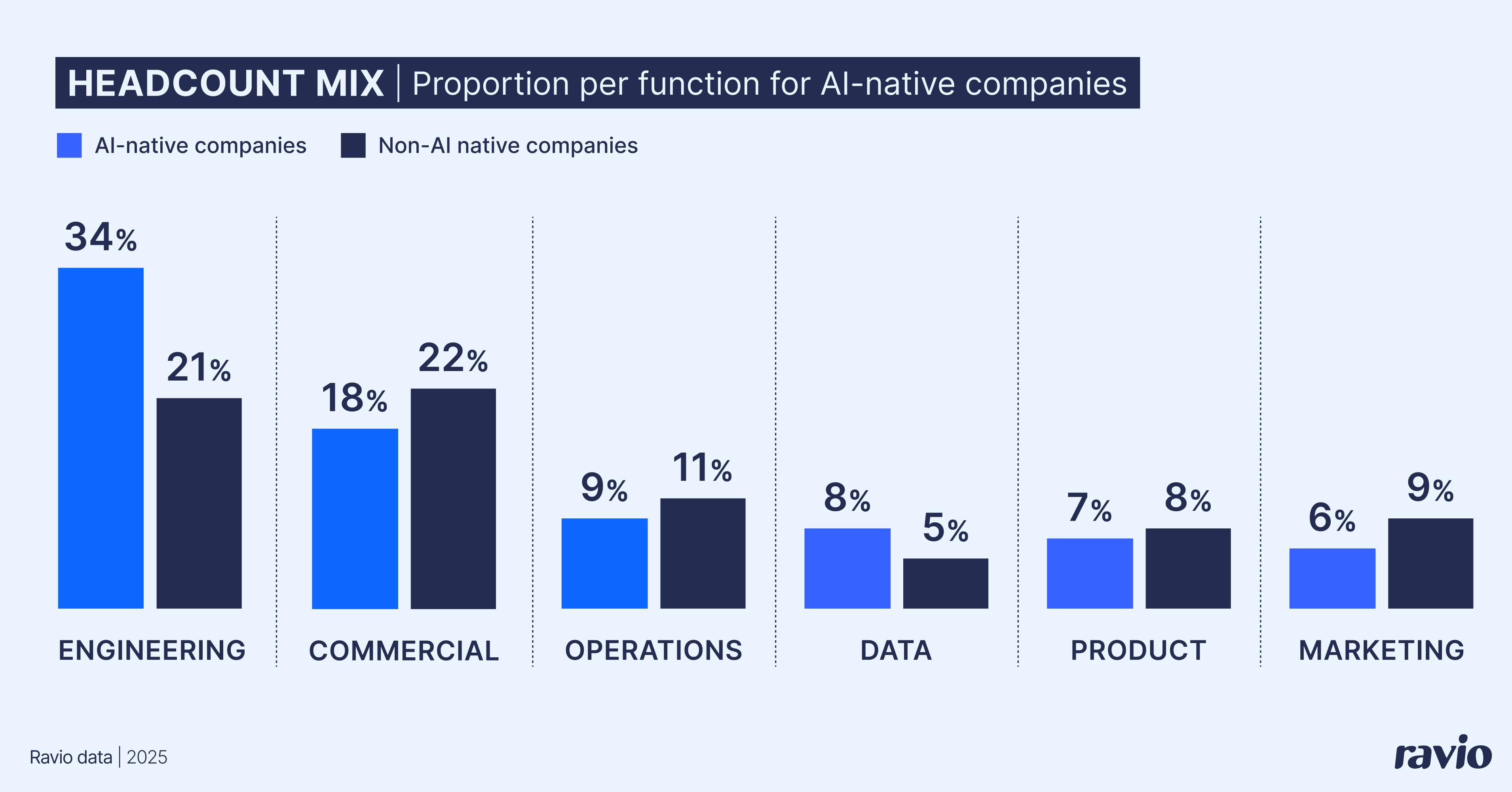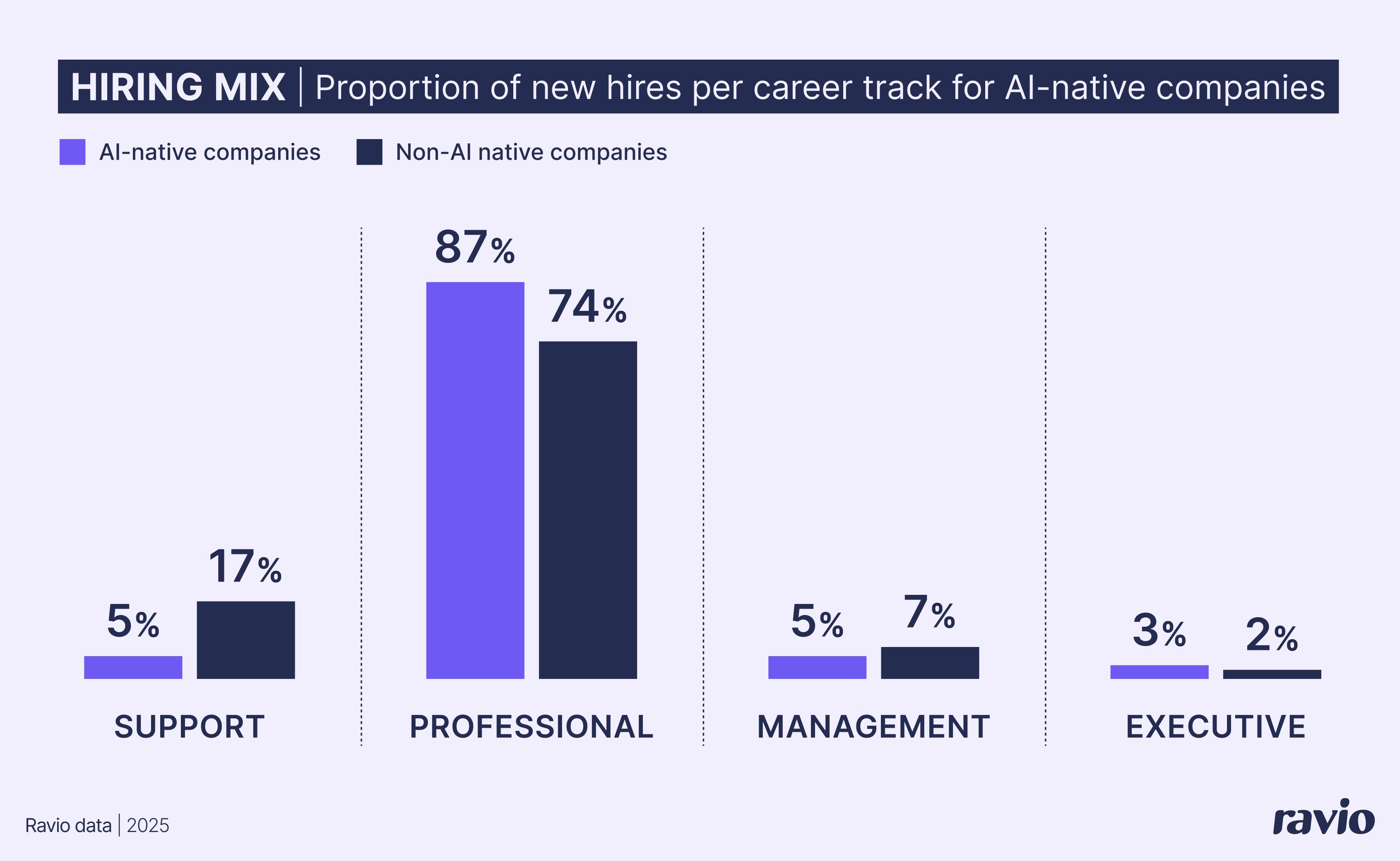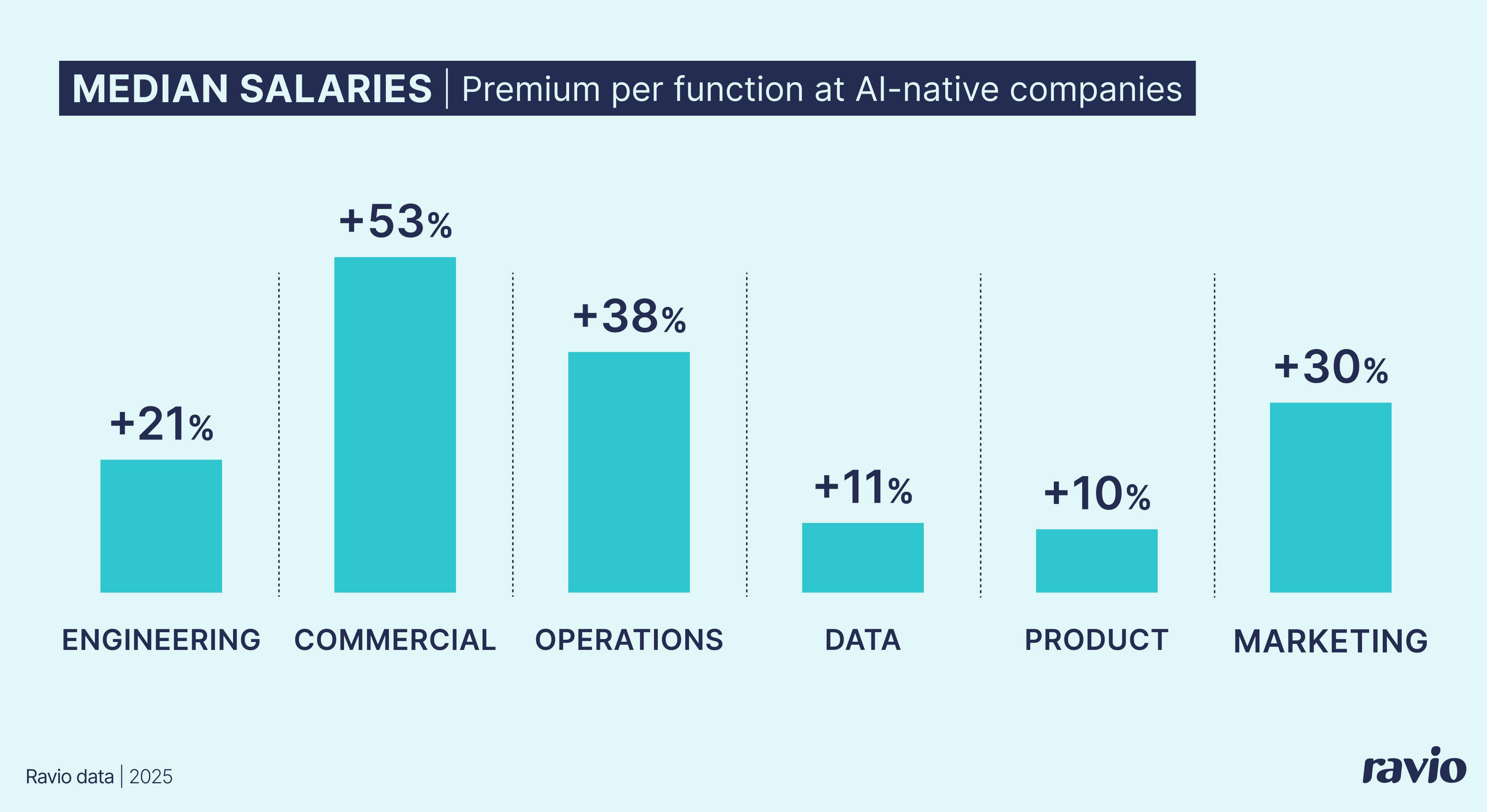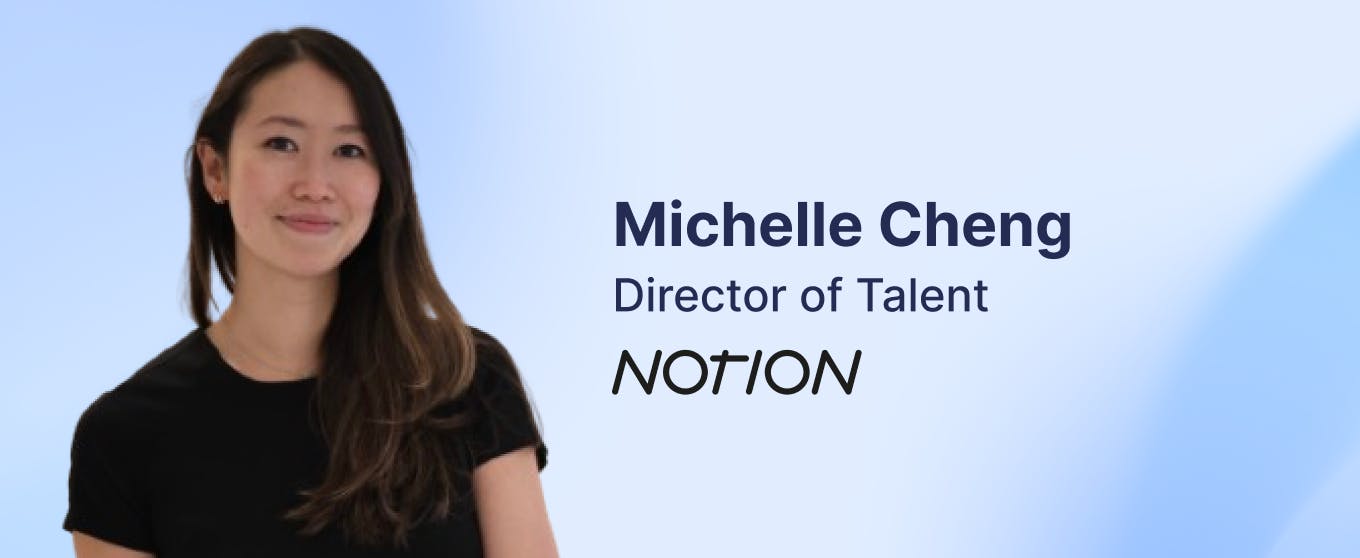Everything we knew about scaling a startup team is changing.
AI-first companies now have 30% fewer employees than traditional startups at the same stage – and they’re paying each of those employees 30% more, across every job function.
According to Michelle Cheng, Director of Talent at Notion Capital, there's a lot that every startup founder and Chief People Officer can learn from how AI-first companies are approaching talent.
"These companies are staying intentionally small until they’re ready to scale," Michelle explains. "They're proving that in the AI-era, having a small team of the right people beats the 'blitz hiring' approach that has been emblematic of VC-funded startup talent strategies for so long."
Let’s take a look at the patterns we found when we dug into Ravio’s data on AI-first hiring and compensation – and get Michelle's take on what it means for the future of startup talent.
Subscribe to our newsletter for monthly insights from Ravio's compensation dataset and network of Rewards experts 📩
AI-native organisation design: Smaller headcount, high agency operators, higher salaries
Ravio’s benchmarks are powered by live data pulled directly from the HR systems of over 1,500 companies (such as Adyen, Wise, and Octopus Energy). It’s a new standard for reliable compensation benchmarking that reflects market reality – including staying on top of the AI trends shaping the talent market today.
From Ravio’s data (August 2025), we can see that AI-first startups (Series A and B) operate with a median headcount of 73 employees, compared to 98 at those that aren’t AI-first. So their teams are overall 34% leaner.
So where are they reducing headcount?
Firstly, in terms of job functions, we can see that AI-native startups have a higher headcount in both their Engineering and their Data teams – but they have a lower headcount across all other analysed areas (Commercial, Operations, Marketing, Product), and are particularly leaner in the Commercial and Marketing functions.

Secondly, when we look across career tracks, we can see that the majority of the headcount reduction in AI-native companies comes from the Support career track. With AI tooling a default in these companies, the need for support-focused roles is greatly reduced.
They’re also hiring slightly fewer management roles, with talent focused largely on the Professional career track – prioritising those ‘doers’ who are building, shipping, and executing day-to-day.

But, these smaller teams don’t mean that AI-first companies are spending less on their talent. On the contrary, the median salary is higher at AI-first startups – 36% higher in the Professional career track overall.
Interestingly, when we look per job function, we can see that every function has a higher median salary in AI-first startups.
But, the median salary is the highest for the Commercial (+50%), Operations (+38%), and Marketing (+30%) functions. Commercial is particularly notable here, with a strikingly high pay premium in AI-first companies.
These are also the functions that are considerably leaner in these AI-first companies – so they’re hiring drastically less in these non-tech functions, but they’re paying a very significant premium to hire only the very best talent for those small teams.

Overall, the data paints a clear picture: AI-native startups are prioritising high agency operators over total headcount.
What do these AI-first hiring patterns mean for startup talent strategies?
The data shows AI-native companies succeeding with radically leaner teams. But what should other startups take from this?
“The takeaway is all about the importance of being intentional about team design right from the start,” Michelle Cheng, Director of Talent at Notion Capital, highlights.
“AI-first companies – with their 34% leaner teams and selective, but premium, hiring – are hiring based on the team they need to achieve specific goals, not to satisfy what’s expected or ‘normal’ at Series A.”
Instead of scaling headcount to signal growth or match competitors, the question becomes: what are your business priorities, and who will drive the biggest impact towards them?
Let’s take a closer look at the lessons Michelle’s taking from exploring how AI-native companies are building their teams.

Lesson 1: Keep hiring plans tight to priorities
The clearest pattern in our data is that AI-first startups are keeping headcount small, and still seeing exponential growth.
"Keep headcount aligned with priorities and build an accountability culture," Michelle suggests. “We are in the age of disentangling hiring and growth, and hiring plans are no longer linear.” Who do you actually need to move the needle towards those goals? Where could AI tooling amplify impact? Which roles or skillsets are worth paying a premium for?
You don't need to go on a hiring frenzy to try and keep up with AI-first companies – they're proving themselves that the opposite approach works.
Intentional design beats reactive scaling.
Lesson 2: The rise of the high agency Super IC (and why they're worth the premium)
Our data shows AI-first companies pay 36% more for Professional-level roles, with some functions seeing even larger premiums.
“These are the ‘super ICs’,” Michelle explains, “experienced professionals who can both design and execute, combining strategic thinking with hands-on delivery – usually using AI – and in a way that eliminates the need for additional layers of support.”
So when you’re thinking about ‘hiring smarter’, Michelle’s advice is to learn from the success we’re seeing from the lean teams of AI-native startups, and “invest in ‘super ICs’ for those roles or skills that you’ve identified as business critical for your goals.”
Think of it this way: you're not paying for one person, you're paying for what used to require a small team. With commercial salaries at AI-first startups 50% higher, it reflects the expectation that these individuals will deliver exponentially more impact.
Lesson 3: Build technical depth first, everything else later
AI-first companies maintain higher Engineering and Data headcount while drastically reducing other functions – especially Commercial and Marketing teams. This isn't accidental.
"For most startups, Engineering and Data teams are the foundation," says Michelle. "Commercial and Ops functions can be kept lean early on."
Establish your technical core first, then add commercial muscle only when genuinely needed – and consider paying that premium to make that commercial muscle the best of the best for your goals.
Lesson 4: Headcount is no longer a success metric
Many traditional scaling metrics assume linear relationships between team size and output – like ARR per employee or ratios like support tickets handled per employee.
The way that AI-first companies are designing their teams breaks these assumptions entirely, because the impact those super ICs have (in combination with AI tooling) is incomparable to your average employee’s output.
“Early-stage organisational health has traditionally been guided by these headcount focused metrics,” Michelle explains, “but with non-linear growth the new normal, we have to start thinking differently to reflect the reality.”
“Instead of chasing headcount ratios, think instead in terms of leverage and outcomes: how much more can each person deliver because of AI and automation.”
“You have to get clear on what ‘scale’ means for your specific company, because the old ‘rules’ of what that looks like from a talent perspective, are being thrown out.”
Instead of tracking org chart growth, focus on impact multipliers. A 20-person team delivering 100-person outcomes isn't understaffed – it's efficiently designed. As Michelle puts it: "Redefine 'scale' for your company, not by old rules."
Lesson 5: Be aware of the risks of super lean teams too
Whilst it’s clear that there are many benefits to be gained from lean teams, if you’re planning to implement a similar approach for your startup it’s also important to note the risks.
“Those high agency operators who have an outsized positive impact on business success, also have an outsized negative impact when they choose to move onto another role,” says Michelle, “and they’re likely to be in high demand on the talent market, so this is an important possibility to consider.”
“Succession planning and knowledge transfer processes become even more important, as do designing proper Rewards plans and retention strategies.”
In summary: Build for your company’s goals, and use impact as your guide, not headcount
The AI-first companies have proven that a small team of exceptional people who can use AI tooling effectively, can achieve remarkable results.
If you're a non-AI startup watching these trajectories, it's natural to wonder how to compete.
The answer isn't to panic-hire in a desire to reach parity, or to blindly copy their playbook.
Instead, take a step back.
Learn from what's working – their focus on exceptional individuals over team size, their willingness to pay for genuine impact, their discipline in staying lean.
But remember that these lessons have to be applied through the lens of your own business.
Think critically about what you actually need to achieve your specific goals. Where would one exceptional person create more value than three average ones? Which roles truly drive your business forward? What can AI tooling handle versus what requires human creativity and judgment?
In the end, it isn't about having a leaner team – it's about intentionally investing in the right people for what your company needs to achieve.



